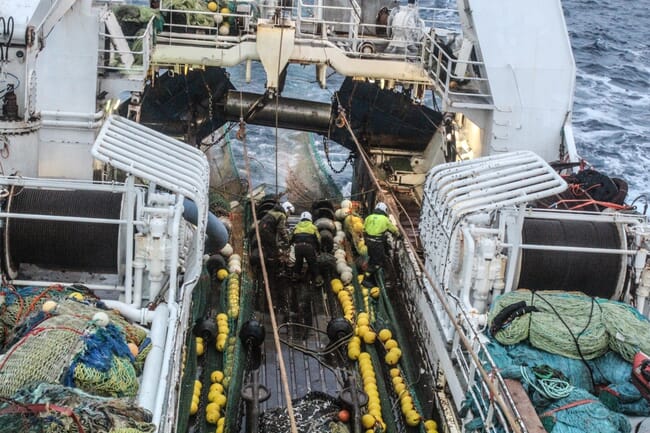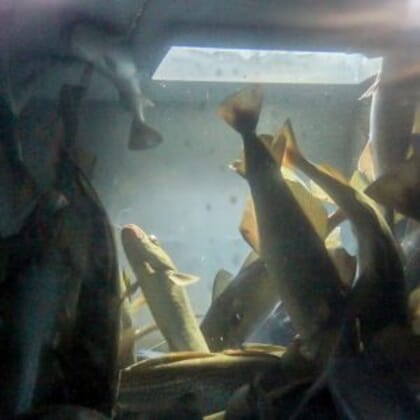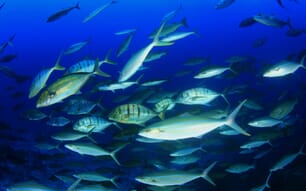Intermediate storage of cod provides better quality fish fillets and may also improve working conditions on board – factors which inspired the Nofima-led study, which involved keeping the cod for six hours in purpose-built tanks on board the trawler’s production deck. It was the first time an intermediate storage tank of this type has been tested in a real fishing situation.

© Stein Harris Olsen, Nofima
“Keeping the fish alive for a few hours on board the trawler means slaughtering can be done in a more controlled fashion – with excellent results. The quality of trawl-caught fish is now close to that of line-caught fish,” says Nofima scientist Stein Harris Olsen, explaining the background to the project he is working on.
“If you make a 20-tonne haul, most of the catch will be dead within half an hour. There is no way you can possibly slaughter such large catches in the first half hour,” the researcher explains.
By storing the catch in a specially designed tank on the production deck of M/Tr. J Bergvoll and providing the fish with a constant supply of new, oxygenated water, the scientists managed to keep the fish alive for six hours while the crew worked on slaughtering the trawl haul. Live storage of catches provides the fishermen with more time to do their work, meaning they can bleed the catch properly. As a result, the trawler can deliver larger quantities of prime quality fish.
“The mortality rate in the tank varied between 5 and 20 per cent for the different hauls, and the average mortality rate was 10 per cent,” says Olsen.
The Nofima scientist has conducted his trials with live intermediate storage in collaboration with the trawl shipping company Nergård Havfiske and the equipment manufacturer Optimar. Nergård installed the live storage tank on one of its trawlers, while Optimar designed the tank and delivered the necessary technology. The research project, called OPTIPRO-3, is funded by Norway’s Fishery and Aquaculture Industry Research Fund. The fishing was done in late October / early November north-east of Svalbard and in the Barents Sea Loophole.

© Stein Harris Olsen, Nofima
“Although I was expecting everything to work, because the tests on land were so promising, even I was surprised that the mortality rate was so low,” Olsen explains.
He believes that part of the reason for the low mortality rate is the fact that the water in the Barents Sea is so cold at this time of year, meaning the fish need less oxygen and have a much slower metabolism. The other reason is that the scientists could run large volumes of water into the custom-designed tank and maintain a high oxygen level in the water at all times.
“We have conducted a few trials in warmer sea water, and the survival rate was always lower. Fish need more oxygen in warmer temperatures. The Arctic species are adapted to life in a cold, oxygen-rich environment. The warmer the water, the more oxygen they need.”
It is known that the oxygen level should not go below 7 milligrams of oxygen per litre of water, otherwise the fish, which are already exhausted, will have problems extracting oxygen from the water.
“During the tests with 2,100 kg of cod in the tank, we managed to keep a steady oxygen saturation of over 85 per cent with the volume of water we had available, which was inflow of 500–600 litres of water per minute into the tank,” says Olsen.
If the fishing had been conducted during the summer, Olsen estimates that they would have needed double the volume of water to maintain sufficient oxygen saturation in the tank.
Improving the end product
The storage system aims to allow the fish recover from the stress of the towing and hauling of the nets. The physical stress the fish are exposed to during trawling causes exhaustion, and lactic acid accumulates in the fish’s muscle tissue. The fish need plenty of oxygen in their blood to break down and remove the lactic acid. In the live storage tank, the fish recover, improving the quality of the end product.
“The cod were pretty spread out in the sea, and we did an average of five hours’ towing with the trawl net at each haul,” Olsen continues. “The catches varied between a few hundred kilos and up to ten tonnes.”
The scientist then had between 500 and 2,100 kilos of fish transferred into the live storage tank at each haul.
Haddock prove harder
“We did the same experiments with haddock, but with significantly lower survival rates,” says Olsen. “Haddock are less robust than cod, and combined with prolonged towing, the results here have not been particularly good so far.”

© Stein Harris Olsen, Nofima
Nevertheless, the scientist believes that shorter towing and smaller hauls will significantly improve the results for haddock too.
“We also had some by-catches, including Atlantic wolffish and Greenland halibut. These two species also recovered very quickly inside the tank,” the scientist added.
Tank design
The live storage tank is designed on the basis of the upstream principle whereby large volumes of fresh water flow up from the bottom of the tank. In this way, waste substances are constantly carried up and out. The tank has a capacity of 4,500 litres and can hold just over 2,000 kilograms of fish.
“Optimar and Nergård must themselves decide what they want to do with these results, but in connection with the construction of new boats, the production deck can be designed with space for these tanks, and water intake can be dimensioned so that each tank will have sufficient inflow to keep the catch alive until the entire catch has been slaughtered.”
The idea is that the tanks are stacked, one on top of the other, with a gooseneck pipe that the fish can be pumped out through. The fish then pass through an electric stunner, followed by a bleed-cutting robot. They are then exsanguinated and gutted. It takes ten minutes to empty a tank and slaughter all the fish in it.
The tank that was used in the trial on M/Tr. J Bergvoll is a prototype and was placed on the trawl deck. During the trial, the fish had to be transferred to the live storage tank manually. In addition, it was only the water from the fire hydrants that was available to supply the live storage tank with water. If live storage tanks for fish are installed on board vessels, the fish will have to be transferred to the tanks via conveyor belt or tubes. There must also be sufficient pump capacity to be able to keep the fish alive until slaughter.
Commercial viability?
“However, the trial proves that the system works, so the question now is whether it will be commercially viable to deliver more fish of better quality,” explains Olsen. “Production will probably be a little more expensive than normal, at least in terms of the initial acquisition, but in the long run it might be possible to reduce the number of employees in the factory.”
On previous research voyages with J Bergvoll under the auspices of the Sustainable fish capture and Pre-processing technology (CRISP) project, Olsen managed to keep cod alive in tanks for 12 hours.
“Cod are quite curious, and after 12 hours they were coming up and looking out of the inspection window on the tank. With a sufficient supply of water, I think good survival rates for more than six hours will be possible, at least for cod,” says Olsen.




